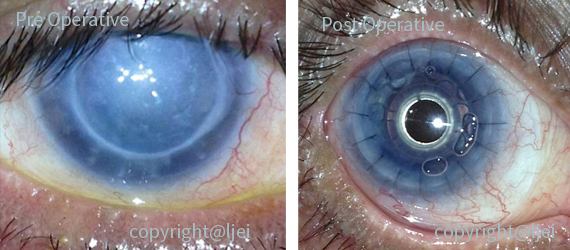K-Pro | Artificial Cornea
In Numbers
Demographics
Technology / Innovation
LJEI is equipped with all the latest and rare Machines / Technology including AI.
Research
We preserve every single case study to handle any complex situation and publish research papers time to time.

K-Pro( Artificial Cornea )
What is Keratoprosthesis?
Who need Artificial Cornea?
One of the advantages of an artificial cornea is that it can help restore vision in patients who are not good candidates for a living corneal transplant from a human donor. The success rate of corneal transplants has increased markedly over the last 40 years, but there are some situations where human donor transplants don’t work. An artificial cornea fills this void. The device is a huge step forward for people with corneal blindness who have rejected human tissue or who live in areas where corneal tissue is not readily available.
Is there such a thing as a bionic eye?
Can a person see with artificial cornea?
How long does an artificial cornea transplant last?
What are the benefits of an artificial cornea?
Can artificial cornea be rejected?
This rejection can occur several months to several years following surgery. Cornea transplant rejection is generally reversible, and if addressed quickly, may not negatively impact the function of the transplanted cornea.
Can you see without a cornea?
Which layer of cornea Cannot regenerate?
How many layers of cornea are there?
The human cornea is comprised of six different cell layers: Epithelium, Bowman’s Layer, Stroma, Dua’s Layer, Descemet’s Membrane and Endothelium. The epithelium is the outermost layer of the cornea and accounts for about 10% of the cornea tissue’s thickness.
Dr. Vikas Mittal for Artifical Cornea Transplant Surgery
Performed 3000+ Cornea Transplant Surgeries
My Approach
Lorem ipsum dolor sit amet, consectetur adipiscing elit. Phasellus vehicula ac nisl ut euismod. Vestibulum id magna rutrum, efficitur neque non, congue ante. Fusce ac finibus sem. Sed nec purus sagittis, euismod neque ac, ultrices lacus. Aenean iaculis lacinia magna, id elementum dolor malesuada sit amet. Sed at mollis velit. Suspendisse cursus, velit eu
Lorem ipsum dolor sit amet, consectetur adipiscing elit. Phasellus vehicula ac nisl ut euismod. Vestibulum id magna rutrum, efficitur neque non, congue ante. Fusce ac finibus sem. Sed nec purus sagittis, euismod neque ac

Yes Artificial Cornea is Available at LJ Eye Institute
Keratoplasty Failure?
Corneal diseases are a leading cause of blindness with an estimated 10 million patients diagnosed with bilateral corneal blindness worldwide. Corneal transplantation is highly successful in low-risk patients with corneal blindness but often fails those with high-risk indications such as recurrent or chronic inflammatory disorders, history of glaucoma and herpetic infections, and those with neovascularisation of the host bed. Moreover, the need for donor corneas greatly exceeds the supply, especially in disadvantaged countries. Therefore, artificial and bio-mimetic corneas have been investigated for patients with indications that result in keratoplasty failure.
Available Cornea Treatments at LJEI
Cornea Transplants
DMEK Surgeries
DSEK Surgeries
C3R Surgeries
We feel proud to say that our doctors train various Cornea techniques to National and International doctors.
Most Advanced Eye Transplant Techniques Available
At LJ Eye Institute we use most advanced Eye Transplant techniques whichever is available in the world, which further help to increase the success rate. Where using traditional techniques the success rate is 70% to 75%, the new techniques increase the success rate to 90% to 95%.These advanced techniques includes DMEK, DALK, DSEK, using such techniques we need not to change whole Cornea and we change only One or required number of layers of Cornea.

Technology @ LJEI
Technology Available For Cornea Treatments at LJEI
LJ Eye Institute employs ultra-advanced technologies for Cornea Transplant procedures.
- We utilize Femtosecond LASER technology for Cornea Transplants, ensuring precision and accuracy compared to conventional blade methods.
- Our facility is equipped with specialized equipment including Specular Microscope for assessing corneal power, Topography, Pentacam, Anterion, and OCT for comprehensive evaluation.
- We integrate the latest available technologies from around the world to achieve the highest success rates in Cornea Transplants.
- For pediatric cases, we have a dedicated spare system and have extensively researched Pediatric Cornea diseases, with publications in national and international medical journals.
- LJ Eye Institute is at the forefront of Stem Cell Transplantation, particularly in the pioneering SLET technique, with numerous published papers showcasing our advancements and modifications in the field.

Still Have Questions?
Cornea Patients Feedbacks

Your content goes here. Edit or remove this text inline or in the module Content settings. You can also style every aspect of this content in the module Design settings and even apply custom CSS to this text in the module Advanced settings.

Your content goes here. Edit or remove this text inline or in the module Content settings. You can also style every aspect of this content in the module Design settings and even apply custom CSS to this text in the module Advanced settings.

Your content goes here. Edit or remove this text inline or in the module Content settings. You can also style every aspect of this content in the module Design settings and even apply custom CSS to this text in the module Advanced settings.

Your content goes here. Edit or remove this text inline or in the module Content settings. You can also style every aspect of this content in the module Design settings and even apply custom CSS to this text in the module Advanced settings.

Your content goes here. Edit or remove this text inline or in the module Content settings. You can also style every aspect of this content in the module Design settings and even apply custom CSS to this text in the module Advanced settings.

Your content goes here. Edit or remove this text inline or in the module Content settings. You can also style every aspect of this content in the module Design settings and even apply custom CSS to this text in the module Advanced settings.



















